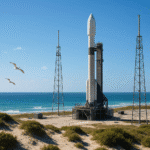Key Takeaways
- In May 2024, xAI officially announced a $6 billion Series B funding round, achieving a post-money valuation of $24 billion, a figure significantly more grounded than earlier speculative targets.
- Key investors in the round included Valor Equity Partners, Vy Capital, Andreessen Horowitz, and Sequoia Capital, indicating broad institutional interest beyond Elon Musk’s immediate corporate circle.
- Persistent speculation about capital flows between Musk’s companies, such as a potential investment from SpaceX, highlights the complex and opaque governance structures within his private empire.
- The strategic rationale for synergy is compelling; xAI’s computational power could directly support SpaceX’s capital-intensive projects in rocket engineering and satellite network optimisation.
- The interconnected nature of Musk’s ventures raises valid questions about concentrated risk and fiduciary duty to the respective minority investors of each distinct entity.
The intricate financial web connecting Elon Musk’s various enterprises has once again become a subject of intense analysis following xAI’s recent capital raise. In May 2024, the artificial intelligence firm confirmed it had secured $6 billion in a Series B funding round, elevating its valuation to $24 billion post-money. [1] While the official announcement named a roster of high-profile venture capital firms, it did little to quell persistent speculation about the role of Musk’s other ventures, notably SpaceX, in providing strategic, if not direct financial, support. This dynamic forces a closer examination of the capital allocation strategies, governance challenges, and potential synergies at play within this unique ecosystem of private technology companies.
The Great Capital Shuffle
The confirmed $6 billion raise provides a moment of clarity in what has been a rather opaque fundraising narrative. Early, and somewhat breathless, reports had suggested xAI was seeking funds at valuations approaching $200 billion, a figure that would have placed it in the uppermost echelons of AI unicorns on the basis of ambition more than demonstrated performance. [2] The actual outcome, while still formidable, represents a more sober assessment of the company’s current state. The round brings xAI’s valuation to a level that, while substantial, is more aligned with its stage of development compared to established players.
The official list of participants lends the endeavour significant institutional credibility. However, the recurring rumours of inter-company investments, particularly from the cash-generative parts of the Musk empire, refuse to dissipate. Such a move would not be without precedent in the world of complex corporate structures, but it introduces layers of complexity and potential conflicts of interest that warrant scrutiny from the minority shareholders in a company like SpaceX, whose own valuation stood at approximately $180 billion following a tender offer in late 2023. [3]
| Metric | Figure | Source / Date |
|---|---|---|
| xAI Series B Funding | $6 Billion | xAI Announcement, May 2024 |
| xAI Post-Money Valuation | $24 Billion | xAI Announcement, May 2024 |
| Key Announced Investors | Valor, Vy Capital, a16z, Sequoia | xAI Announcement, May 2024 |
| SpaceX Reported Valuation | ~$180 Billion | Bloomberg, December 2023 |
A Symbiosis of Silicon and Steel
Beyond the pure financials, the strategic case for a tighter alignment between xAI and SpaceX is arguably more compelling. Modern aerospace engineering and logistics are fundamentally problems of immense computational scale. SpaceX’s core missions, from designing and testing reusable rockets to managing the vast Starlink satellite constellation, are heavily reliant on advanced modelling and data analysis.
There are several areas where a dedicated, in-house AI powerhouse could provide a decisive competitive advantage:
- Engineering and Simulation: The development of vehicles like Starship requires countless hours of computational fluid dynamics (CFD) and structural stress simulations. A powerful AI model could dramatically accelerate this process, optimising designs for performance and reusability far more rapidly than traditional methods.
- Network Optimisation: The Starlink constellation is a dynamic, orbital network of thousands of satellites. Managing traffic, predicting coverage gaps, and routing data efficiently is a logistical challenge of the highest order, perfectly suited for an AI-driven control plane.
- Autonomous Operations: Looking further ahead, missions to Mars and beyond will necessitate unprecedented levels of autonomy. An AI developed with the specific goal of navigating and operating in complex, remote environments would be an invaluable asset, reducing reliance on slow, light-speed-delayed communication with Earth.
From this perspective, any capital flowing towards xAI could be framed not as a speculative bet, but as a strategic investment in vertical integration, securing a critical component of the technological stack required for future growth.
Conclusion: The Inevitable Conglomerate?
For investors and market observers, the primary takeaway is the increasingly blurred line between Musk’s corporate vehicles. The movement of capital, talent, and technology between these firms suggests a long-term strategy that transcends the individual balance sheets of Tesla, SpaceX, or xAI. This raises legitimate questions about governance. How are the interests of external investors in one entity protected when capital might be deployed to bolster another, legally separate, entity?
The answer may lie in a hypothesis that has been gaining traction for some time: that this is all a precursor to an eventual consolidation. One could envision a future where these distinct companies are rolled up into a single holding structure, a modern-day conglomerate focused on what might be termed ‘hard technology’. Such a move would formalise the symbiotic relationships that are currently managed through informal and opaque channels. It would create a vertically integrated behemoth spanning energy, transport, communications, and intelligence, a structure whose ambition would be to solve humanity’s most significant engineering challenges. Whether this grand vision can overcome the immense financial and governance hurdles remains the critical, multi-billion-dollar question.
References
[1] xAI. (2024, May 26). xAI Announces $6 Billion in Series B Funding. Retrieved from https://x.ai/blog/series-b
[2] Primack, D. (2024, January 26). Elon Musk’s xAI is raising $6 billion to challenge OpenAI. Axios. Retrieved from https://www.axios.com/2024/01/26/elon-musk-xai-raising-6-billion-openai
[3] Bloomberg. (2023, December 12). SpaceX Valued at $180 Billion in Tender Offer. Retrieved from https://www.bloomberg.com/news/articles/2023-12-12/spacex-in-talks-for-tender-offer-at-175-billion-valuation-or-more














